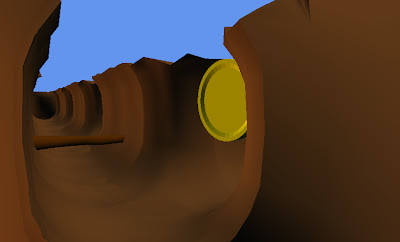The goal of the project is to see how gaze and voice can be used to interact in video games. In my last post I went through the game design implications arising from running the user trial. The main implication being that of time constraint. That is, the game needs to be simple enough for participants to get to grips with in order to play it at least twice within 20 minutes.
Obviously while the game needs to be simplistic enough to allow for a quick turn-around of participants, it also needs to be challenging enough so that any data gathered is valid. The game should include as many common gaming tasks as possible, such as, navigation, object selection and so on. I also wanted the game to have a fun, action, adventure, cartoon-like feel.
So with all this in mind, the concept for the game is as follows: the player is trapped in a rabbit warren, inhabited by evil bunny rabbits, from which they must escape. Players will be presented with a labyrinth of tunnels which they must find their way out of, collecting coins along the way, all the while avoid evil rabbits. Once the exit is found, players can only gain freedom (and win the game) depending on the number of coins collected. I have given it the working title "Rabbit Run".
 The game is in first-person perspective, which, I think, lends itself well to gaze input. The above screen capture is taken from a demo I am working on at the moment. It shows the tunnels, the player must navigate through and one of the coins which must be collected along the way. Notice too the root in the tunnel, an obstacle which players must jump over. There will also be other roots higher up the tunnel wall, making players crouch to get past. Players will be given a map to guide them through the maze, which shows the areas of the maze traveled through. More on this in a later post, since there will be a subtle difference when using gaze interaction.
The game is in first-person perspective, which, I think, lends itself well to gaze input. The above screen capture is taken from a demo I am working on at the moment. It shows the tunnels, the player must navigate through and one of the coins which must be collected along the way. Notice too the root in the tunnel, an obstacle which players must jump over. There will also be other roots higher up the tunnel wall, making players crouch to get past. Players will be given a map to guide them through the maze, which shows the areas of the maze traveled through. More on this in a later post, since there will be a subtle difference when using gaze interaction.
Obviously while the game needs to be simplistic enough to allow for a quick turn-around of participants, it also needs to be challenging enough so that any data gathered is valid. The game should include as many common gaming tasks as possible, such as, navigation, object selection and so on. I also wanted the game to have a fun, action, adventure, cartoon-like feel.
So with all this in mind, the concept for the game is as follows: the player is trapped in a rabbit warren, inhabited by evil bunny rabbits, from which they must escape. Players will be presented with a labyrinth of tunnels which they must find their way out of, collecting coins along the way, all the while avoid evil rabbits. Once the exit is found, players can only gain freedom (and win the game) depending on the number of coins collected. I have given it the working title "Rabbit Run".
 The game is in first-person perspective, which, I think, lends itself well to gaze input. The above screen capture is taken from a demo I am working on at the moment. It shows the tunnels, the player must navigate through and one of the coins which must be collected along the way. Notice too the root in the tunnel, an obstacle which players must jump over. There will also be other roots higher up the tunnel wall, making players crouch to get past. Players will be given a map to guide them through the maze, which shows the areas of the maze traveled through. More on this in a later post, since there will be a subtle difference when using gaze interaction.
The game is in first-person perspective, which, I think, lends itself well to gaze input. The above screen capture is taken from a demo I am working on at the moment. It shows the tunnels, the player must navigate through and one of the coins which must be collected along the way. Notice too the root in the tunnel, an obstacle which players must jump over. There will also be other roots higher up the tunnel wall, making players crouch to get past. Players will be given a map to guide them through the maze, which shows the areas of the maze traveled through. More on this in a later post, since there will be a subtle difference when using gaze interaction.For the 3D models I have been getting help from a friend of mine, Rod Flynn, a graphic designer, who runs Who Design. He is interested in learning some more about 3D modelling and animations for games and has very kindly agreed to help out with the models used in the game. His expertise in 3ds Max has accelerated the creation of 3D models and to a higher standard than I could hope to achieve myself.
I leave you with a quick video of navigation through the warren. This particular video is fairly basic with no collision detection even. I will post new videos as I add more features.